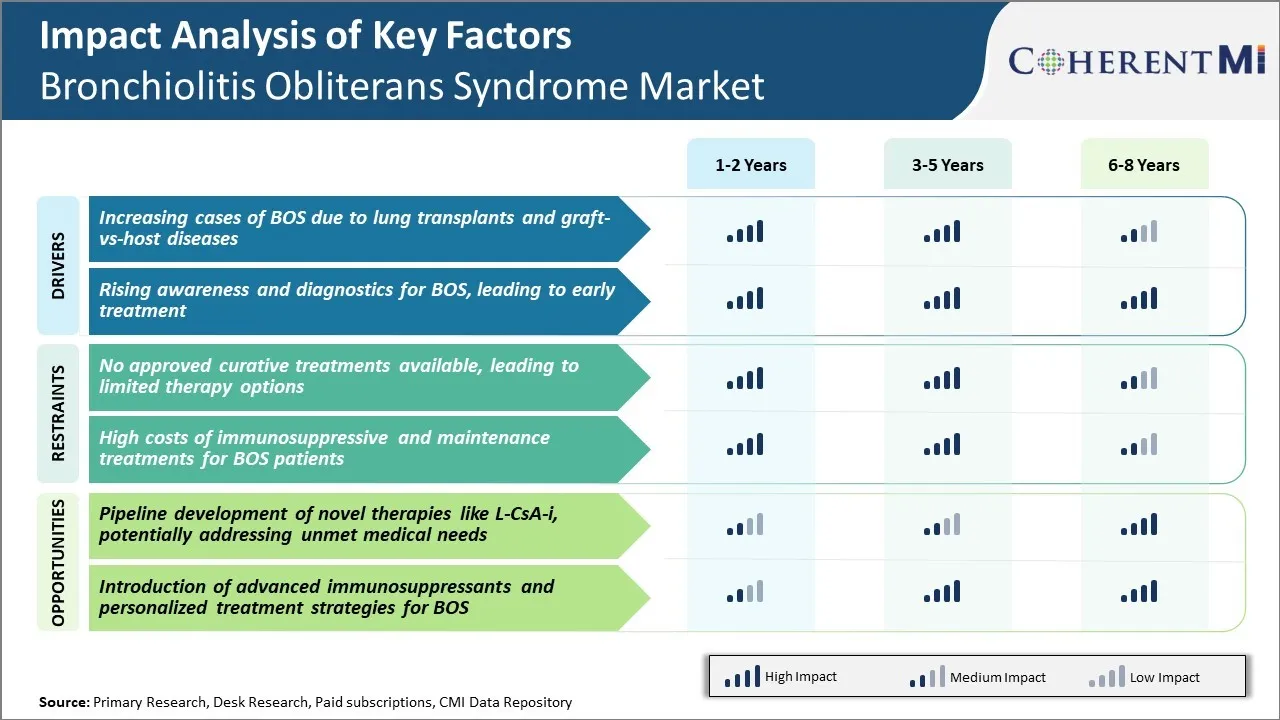Bronchiolitis Obliterans Syndrome Market ANALISI DIMENSIONE E QUOTA - TENDENZE DI CRESCITA E PREVISIONI (2024 - 2031)
Bronchiolitis Obliterans Syndrome Market è segmentato da Therapy (Budesonide/Formoterol, Montelukast, N-acetylcysteine), Da Drug Class (Macrolide Anti....
Bronchiolitis Obliterans Syndrome Market Tendenze
Driver di mercato - Aumentare i casi di BOS a causa di Trapianti polmonari e Malattie di Graft-vs-Host
BOS prevede la formazione dei tessuti cicatrici, nota come crescita dei tessuti fibrosi, che restringe le vie respiratorie nel tempo e limita il flusso d'aria a causa del rifiuto dei polmoni trapiantati dal sistema immunitario del corpo. Malattie del seno-vs-host (GVHD) dopo il trapianto di cellule staminali ematopoietiche è una causa principale che aumenta il verificarsi di BOS.
Il numero di pazienti sottoposti a procedure di trapianto polmonare continua ad aumentare ogni anno a livello globale, perché l'insufficienza polmonare è diventata una causa principale di mortalità. Mentre il trapianto è un'opzione salvavita per i pazienti con malattie polmonari di fine fase, come la fibrosi cistica, la fibrosi polmonare, l'ipertensione polmonare ecc., la terapia immuno-soppressione permanente somministrata post-chirurgia ha la sua parte di rischi.
Secondo gli ultimi dati, BOS si sviluppa in quasi il 30-50% dei destinatari del trapianto polmonare entro 5 anni di procedura di trapianto principalmente a causa del rifiuto cronico dell'organo trapiantato. L'infiammazione persistente e la cicatrice distrugge progressivamente le piccole vie aeree nel tempo limitando il movimento dell'aria in e fuori dei polmoni. I pazienti GVHD che ricevono cellule staminali da un donatore vivo o defunto sono anche vulnerabili a sviluppare BOS come complicazione a lungo termine. La distruzione infiammatoria innescata da cellule immunitarie innestate contro i tessuti e gli organi ospiti possono coinvolgere anche i passaggi dell'aria dei polmoni.
Driver di mercato - Rising Awareness and Diagnostics for BOS, che porta al trattamento precoce
Prima, la diagnosi è stata stimolante come sintomi imitare altre malattie respiratorie nelle fasi iniziali. Tuttavia, i test di funzione polmonare migliorati, le scansioni CT ad alta risoluzione e i metodi di biopsia hanno permesso ai patologi e ai medici di rilevare i primi segni di ostruzione e cicatrici in piccole vie aeree causate da complicazioni post-trapianto.
Allo stesso tempo, i gruppi di advocacy del paziente e le comunità di supporto online stanno educando le persone su fattori di rischio come le infezioni polmonari croniche, l'assenza di farmaci, la storia del rifiuto cellulare acuto, bronchiolite obliterante vista su campioni di biopsia transbronchiale.
La diagnosi precoce consente ai medici di avviare interventi di trattamento in modo tempestivo prima che il danno ai polmoni diventi permanente e irreversibile. Le strategie terapeutiche comuni seguite includono la regolazione di farmaci immunosoppressivi, l'uso di inalatori più recenti che forniscono farmaci steroidei direttamente a piccole vie aeree, terapia fotoferesi, interventi di riduzione del volume polmonare. Gli studi di ricerca sono in corso per valutare l'efficacia di farmaci come Macitentan, Imatinib che mirano a vie correlate alla fibrosi.
Nel complesso, una migliore consapevolezza sul riconoscimento dei sintomi e dei segni, valutazioni diagnostiche migliorate e disponibilità del piano di gestione diversificato quando BOS viene diagnosticato a fasi iniziali sono suscettibili di migliorare i risultati di trattamento per coloro che soffrono di questa condizione polmonare. Questo presenta anche lo scopo per evitare complicazioni a lungo termine.

Sfida di mercato - Nessun trattamento curativo approvato disponibile, portando a opzioni di terapia limitate
Attualmente non sono disponibili trattamenti curativi approvati per BOS. Le opzioni di trattamento esistenti sono limitate e si concentrano principalmente sulla gestione dei sintomi per rallentare la progressione della malattia. Il trapianto polmonare è l'unico trattamento che può potenzialmente ripristinare la funzione polmonare, ma ha un tasso di successo limitato e i rischi di complicazioni post-trapianto e rifiuto innesto rimangono elevati.
La mancanza di terapie farmacologiche efficaci che possono indirizzare direttamente la patofisiologia sottostante di BOS pone una grande sfida per i pazienti. Significa anche che i medici hanno opzioni limitate tra cui scegliere quando si trattano i pazienti in diverse fasi della malattia. L'indisponibilità dei trattamenti curativi è una preoccupazione chiave che frena la crescita del mercato globale del BOS.
Opportunità di mercato - Potenziale delle Terapie di Novel
Lo sviluppo della pipeline di nuove terapie per BOS presenta significative opportunità per affrontare le principali esigenze mediche non misurate sul mercato. Un candidato promettente è la ciclosporina inalata A (L-CsA-i), che viene valutato per la sua capacità di rallentare potenzialmente la progressione del BOS sopprimendo i meccanismi immunologici coinvolti.
I risultati degli studi clinici iniziali sono stati incoraggianti, mostrando miglioramenti nei parametri della funzione polmonare nei pazienti che ricevono L-CsA-i rispetto al placebo. Il suo approccio mirato di somministrazione di droga polmonare può aiutare a raggiungere concentrazioni localizzate più elevate, riducendo l'esposizione sistemica e gli effetti collaterali rispetto agli immunosoppressori orali.
Il successo nelle prove di fine stadio potrebbe significare che L-CsA-i diventa la prima terapia non-trapianto approvata per BOS. Questo ha il potenziale di trasformare i paradigmi del trattamento fornendo ai medici un'opzione efficace per gestire la malattia a lungo termine. Si sta anche per migliorare notevolmente i risultati del paziente e la qualità della vita.
Ciò mette in evidenza le opportunità significative nuove terapie pipeline presenti per crescere significativamente il mercato della sindrome di bronchiolitis obliterans nei prossimi anni affrontando le esigenze mediche non meritevoli critiche.